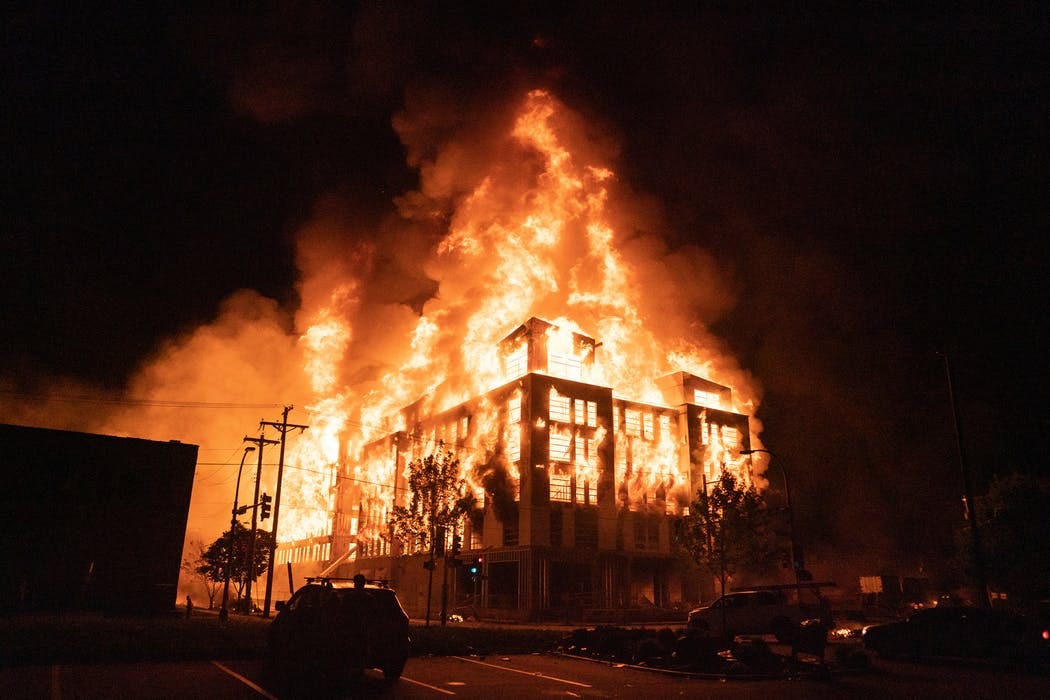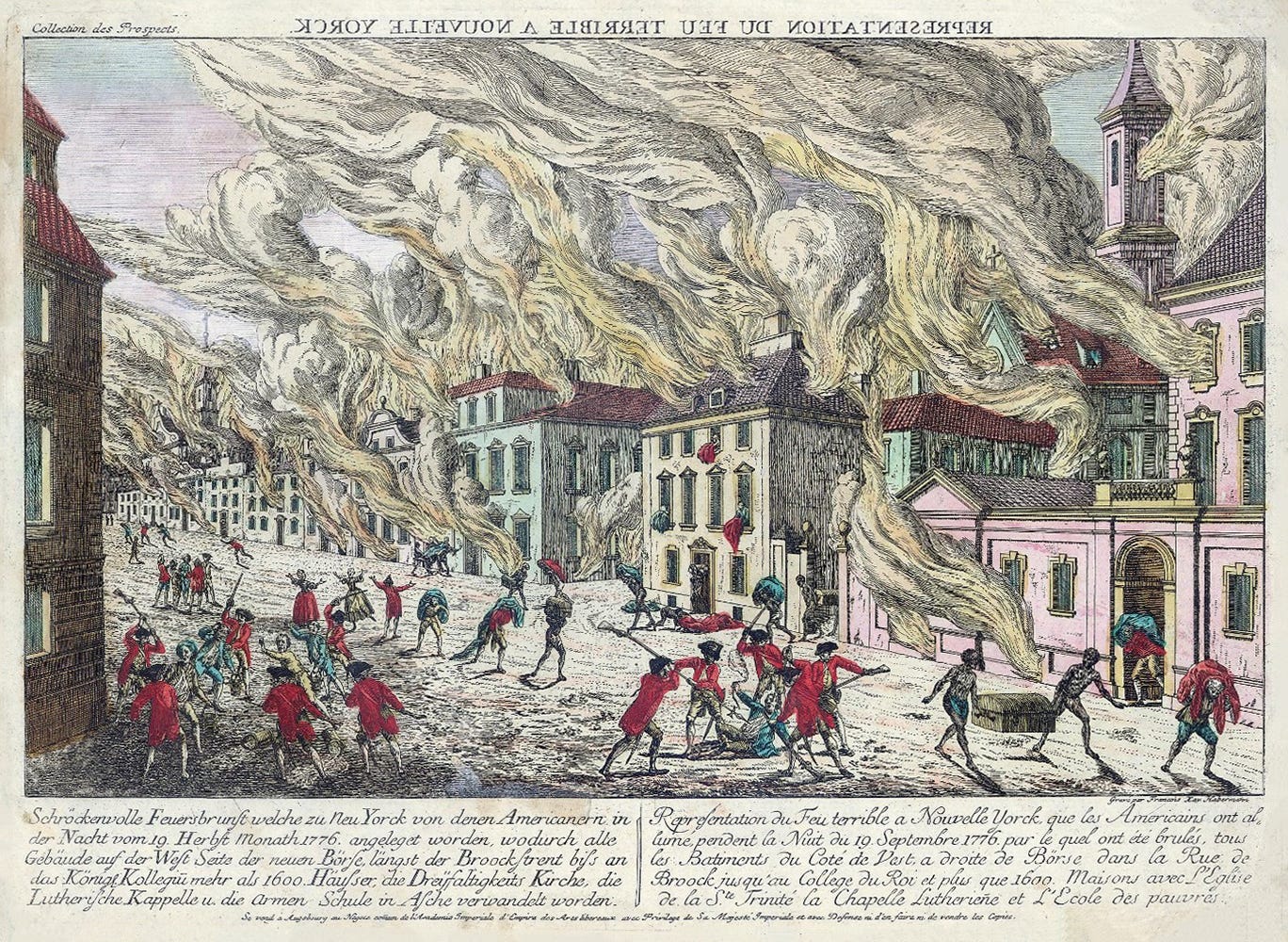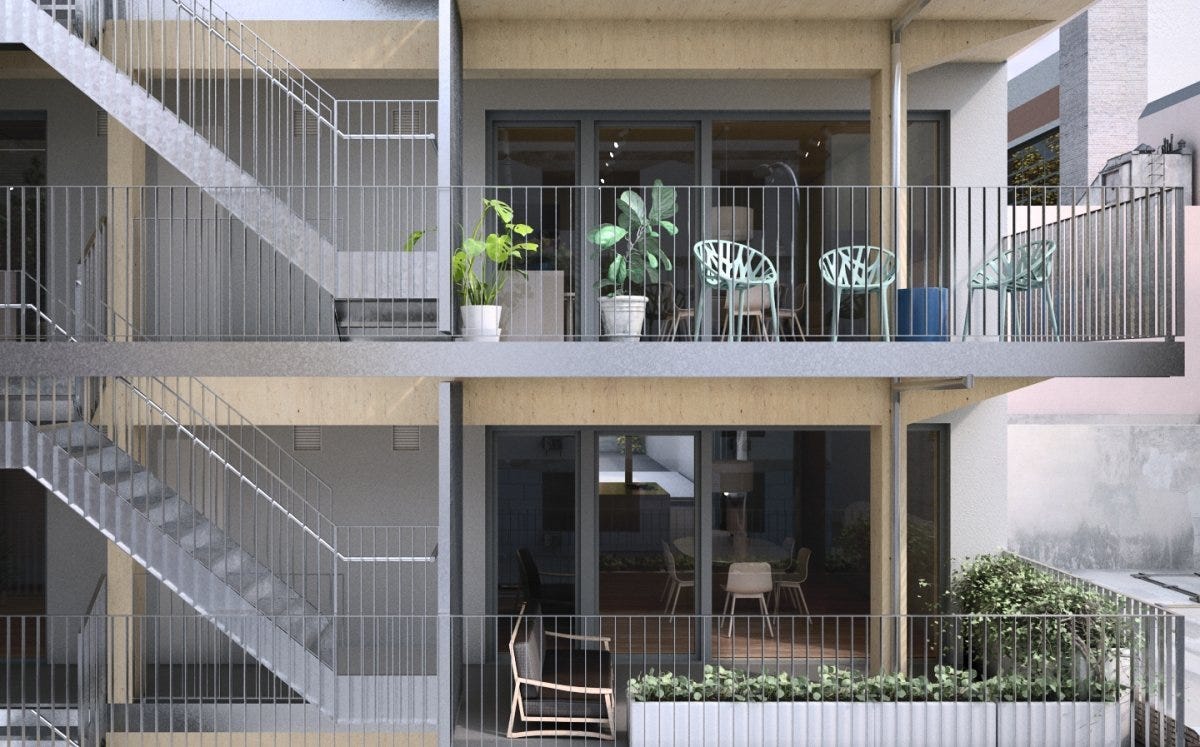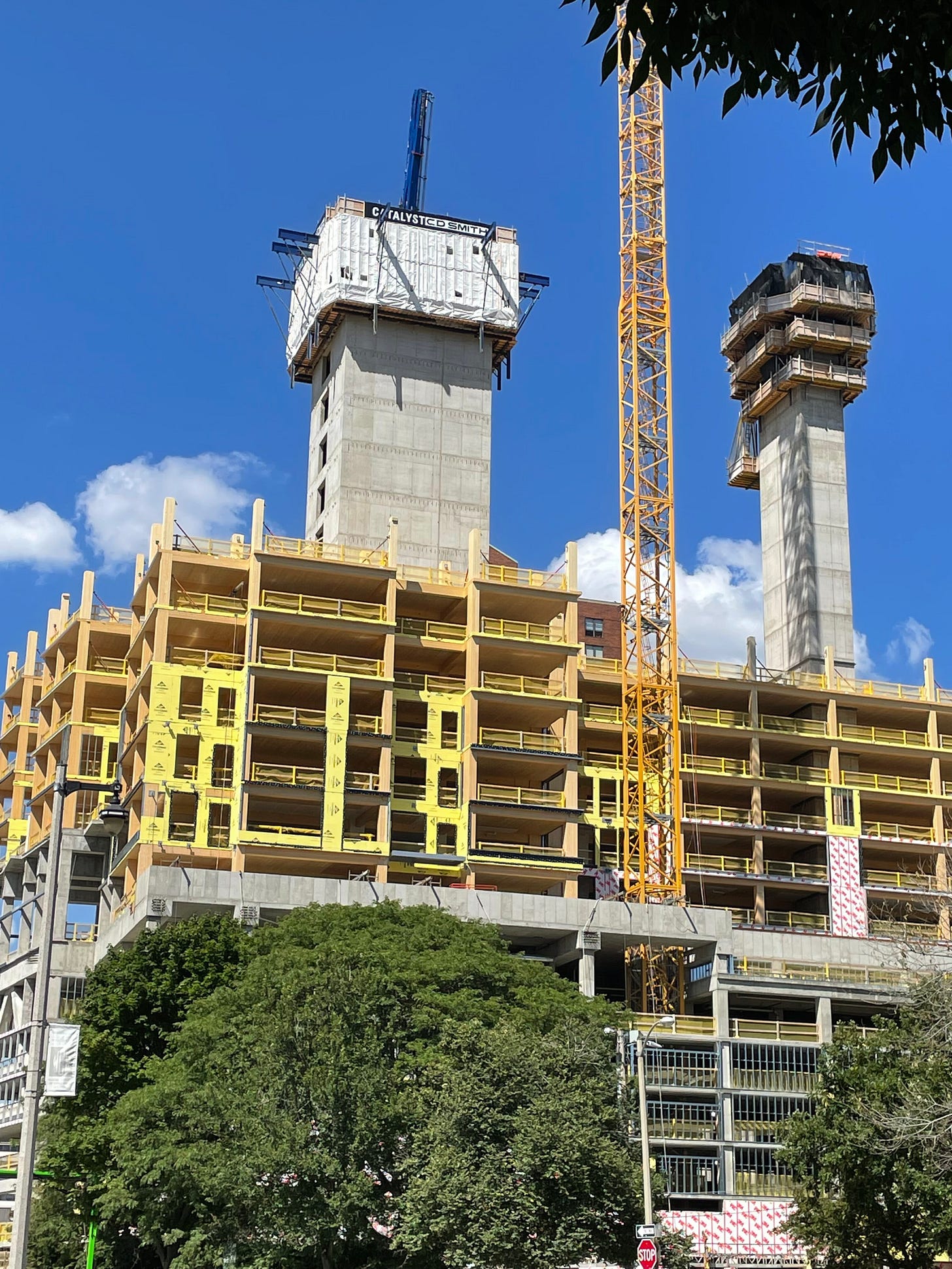Welcome! If someone forwarded you SKYLINE, sign up here to receive it weekly.
I have been in the Midwest for most of August, and wherever I go, I see new wood-framed apartment blocks, the so called 5-over-1 or ‘podium’ because it is five stories of wood on one story of concrete - that is, a podium. Fresh podiums are in Kansas City, in Iowa City, Columbus (Ohio), Indianapolis, Columbia - some are alright, many are mediocre, some are bad, and a few are borderline criminal. On the criminal side, last summer a set of wood-framed dorms in Kansas City were demolished less than ten years after they opened in 2012.
If you live in New York and never get out of town, you may have missed this phenomenon, because in New York the podium is illegal. Or at least was. This morning we share a piece from Issue #20 by Chris Gardner, about the potential and pitfalls of wood construction, and the campaign to bring it into New York.
- Nicolas Kemper
**For those worried about the woman in Kabul I talked about in the opening of last week’s issue, as of this past weekend she was at the airport in Kabul and slated to leave. In reviewing some of my old correspondence about the topic, I came across this 2017 article, about efforts to re-route traffic arteries to widen the green zone and establish a truck-free ‘blue zone’ covering most of Kabul - a rare piece on urban planning in the service of nation-building, but I never found any follow up coverage on the topic.**
The Podium comes to New York
by CHRIS GARDNER

Amid the demonstrations following the killing of George Floyd in police custody last summer, an apartment complex in Minneapolis burned to the ground. The building, an affordable housing development under construction on East Lake Street, was a 5-over-1 podium building (sometimes simply called a podium, for short), so-called because of its five stories of wood stud framing set atop a concrete base, often reserved for commercial space or parking. On the night of its conflagration, the building was in a particularly vulnerable state of construction, with the majority of its wood framing erected but only portions of its fire-suppressive gypsum board sheathing affixed to the frame. At that moment, the building had more in common with a bonfire than a piece of architecture, and indeed, it burned as ferociously, leaving only the flame stained concrete base and stair tower standing by morning.
The podium has defined building construction in the United States for the past generation, becoming the near-universal approach for multi-family housing developments in both cities and suburbs. The East Lake Street fire brought to the surface broader opinions that have formed about this type of building—not only the podium, but also wood stud construction in general—as cheap, unsafe, and ugly. For many, the fire signified a rejection of the building's inferior quality as well as its gentrifying presence within the community. Even in a world where, per Frank Gehry, “98% of what gets built is shit,” the podium style has distinguished itself by exceptional ugliness, as evidenced by the popularity of social media accounts like @DenverFUGLY, which “celebrates the stupid crap that is being built” and creates a forum “to demand more from those that are doing stupid shit.”
While wood construction in the form of the podium may be popularly reviled, wood has been met with nothing but growing enthusiasm in some corners of the architecture and engineering world over the past decade, topped off by the recent inclusion of expanded timber provisions in the 2021 edition of the International Building Code (IBC). This enthusiasm is tied not to stud framing but to a new form of wood structure. Mass timber—the name given to a class of engineered structural timber products—seeks to redeem wood architecture.
This March, at TimberCon, a building industry conference focused on timber, practitioners across North America discussed such topics as STC ratings, shaft wall fireproofing, and outlet integration—a level of technicality reflecting a drive towards real-world applicability. At the academic level, mass timber has been fully embraced, championed by practitioners such as Jennifer Bonner and Hanif Kara at Harvard GSD, and David Benjamin and Lindsey Wikstrom at Columbia GSAPP. And then there is the "disruptor" class of tech companies, which see in timber a chance to establish themselves more deeply within the building industry. The Alphabet Inc–owned urban innovation organization Sidewalk Labs, for instance, is developing mass timber prototypes, which it had planned to use for its (now cancelled) Toronto smart city project, Quayside.
For all of the fanfare, there remains a disconnect between the promise of mass timber and the realities of construction in most American cities. A surge of wood construction is being driven not by mass timber, but by the podium.
The story of the podium begins with fire. Long before the East Lake Street fire, wood construction, particularly in urban areas, was associated with fire. In New York City, for example, the Great Fire of 1776 claimed nearly a quarter of the city’s buildings. Then came the Great Fire of 1835, which destroyed 600 buildings. The logical culprit, the city said, was wood, so it passed an ordinance calling for all new construction to be built with noncombustible stone and brick—the first such regulation against a construction material in the city’s history. The regulations proved themselves useful when the Great Fire of 1845—started by a warehouse explosion—stopped short upon reaching the new stone and brick buildings. (Incidentally, the first printed versions of the fairytale "The Three Little Pigs," with its pro-brick messaging, appeared in the 1840s.) Additional regulations followed, to the point where, today, New York code prohibits wood stud framing—Type V construction—for new buildings and additions in designated “fire districts,” bluntly defined as “all of the borough of Manhattan / Brooklyn / Bronx and portions of Staten Island and Queens.”
At first, cities across the rest of the country, prompted by their own fires, followed suit, effectively banning wood from multi-unit—that is, urban—construction. But in the early 1990s, according to a 2019 Bloomberg Businessweek article, Los Angeles architect Tim Smith found a loophole: a code provision that would allow for stud framing (combustible) above a concrete ground floor (non-combustible), thereby radically reducing construction costs for mid-rises, which were previously required to be only steel or concrete.
Smith’s inaugural podium-style building, Casa Heiwa, opened in 1996. Soon after, the podium quickly gained popularity among California developers. Following the 2009 recession, the podium spread across the country, spurred by speculative construction in cities and the sudden availability of lumber and skilled contractors who had previously been deployed at peripheral single-family construction sites.
The podium’s characteristic appearance—the consequence of bottom-line considerations, rather than any one architectural style—lives up to its loathed reputation. The outside material choice is selected from a palette of Exterior Insulation and Finish System (EIFS), vinyl siding, or facing brick. Any attempts at unifying the disparate parts are made entirely through the design of the façade, using different materials or colors in an attempt to "break up” the mass: a gross over-simplification of the most basic tenets of architectural composition.
For residents of contemporary podium buildings, units border on unlivable. Flooring is laid directly on top of the joists, while the undersides of gypsum board and plaster are laminated to make the ceiling, creating a singular assembly that translates any and all vibration downward—every downstairs neighbor's worst nightmare. Plus, the extensive use of gypsum board, low-quality, high-VOC (Volatile Organic Compounds) paint, and synthetic fire-resistant finishes all contributes to off-gassing indoor pollutants at rates well above what is recommended.
While the rest of the country has embraced the podium, New York City has been slow to give up its mistrust of wood construction. The city has no 5-over-1 developments, and almost no wood-construction buildings outside of historic structures. But the tide is shifting. After a few failed attempts—most notably, the 2015 ten-story all-timber building at 475 West 18th in Chelsea, designed by SHoP Architects—at the time of publication there are three recently completed projects that utilize mass timber, and two more under construction. All five are in Brooklyn.
Completed in 2020, Frame 283 in Clinton Hill uses cross-laminated timber (CLT) to support a five-story, 10-unit residential building. Designed by local architecture studio Loadingdock5, the structure exemplifies the firm's knack for subtle innovations in infill housing like exterior stairs and generous terraces. In 2019, Flank Architecture + Development completed two commercial mass timber buildings, 320 and 360 Wythe. Currently permitted and under construction are 80 Ainslie, which is being built with CLT, and 670 Union, which sports a glue-laminated (glulam) structure.
Unlike the podium, New York's mass timber buildings firmly position themselves within the luxury rental market, trading gypsum board and cheap paint for exposed wood (where allowed) and high-end finishes. It was, however, a fluke that they made it through code at all. The first CLT building in the city, Frame283 should not have been approved in the first place. Unfamiliar with the material, plan reviewers mistakenly granted the building permit, only to later threaten to rescind approval (they settled for a few more sprinkler heads instead). In the case of 320 and 360 Wythe, reviewers forced Flank to replace glue-laminated timber with the antiquated nail-laminated timber, since the NYC Building Code includes the nails but not the glue. By including provisions for CLT, the forthcoming 2021 edition of NYC Building Code should dispel this confusion, but “the political headwinds are strong,” said Tanya Luthi, a structural engineer and member of both the WoodWorks Board of Directors and the NYC structural code committee, in a phone interview.
The case mass timber advocates are making to code committees in New York differs from that which won podium construction approval elsewhere. Podium construction relies on the understanding that, because wood burns, it needs to be surrounded by something that does not burn. By contrast, mass timber advocates must convince the public that it is actually just fine for wood structures to burn. Imagine trying to set a log on fire with a match—you may char the outside but you will not set the full log ablaze. This is an accurate analogy for mass timber during a fire. The exposed sides form a sacrificial char layer, thereby protecting the unexposed parts of the structure from catching fire for many hours. In a blaze, all structures have a point of failure, whether they are made of wood, steel, or concrete. The goal of code is to put off that point as long as possible, in order to provide enough time for evacuation and for firefighters to perform their duty. With this understanding, mass timber has potential far beyond the limits imposed upon the podium style, creating potential for high-rise construction that will not only be more aesthetically appealing, but also safer for its residents, visitors, and neighbors.
Submitted to the City Council for review in late April, the updated code will be put to vote in six to nine months, and, if approved, it will be adopted soon after. Anyone privy to city politics could tell you that this is far from a sure thing, but it is a hopeful development nonetheless. For a city that has long operated under its own rules for building, particularly with regard to wood construction—wood stud framing is still entirely prohibited in Manhattan and most of the other boroughs—this possibility is all the more exciting.
“In a lot of ways, New York is the perfect place for mass timber,” says Luthi. She cites its quick assembly, which reduces costly on-site labor, and light weight, which has potential for overbuild applications and opens up possibilities for sites with undesirable subsurface conditions. Similarly, the “sweet spot” for mass timber construction—where costs and schedules are at their most competitive—is from 10- to 18-stories. In New York, this range accounts for the majority of new buildings above 75 feet. Worth noting is that the code updates for NYC currently in review are based on the 2015 and 2018 IBC, not the 2021 version, which includes provisions for timber at these heights. For this reason, the “sweet spot” will have to wait until the next code review cycle in 2025 for a chance to be included.
Nonetheless, should the new New York Building Code weather the political gauntlet, we may soon find ourselves in a new era of wood building. If and when CLT becomes fair game, all of the speculations and mounting excitement about mass timber in the US, from academia to the tech world, can begin to play out.
Outside New York, will mass timber replace the podium? No: according to Luthi, “for projects up to six stories where cost is the primary driver, mass timber will have no chance of competing with stick frame.” To put the challenge simply: a twelve-foot wall requires only eight studs and six sheets of gypsum board. To make the same wall with CLT, you need to laminate together around 72 studs. Outside the wealthy bubble of New York City, at a time when lumber prices have spiked 360 percent, the argument for replacing wood with more wood becomes all the more implausible for typical construction.
Perhaps the most promising aspect of the recent developments with mass timber is not the actual code changes or even the expanded implementation, but rather the renewed awareness that code can be dynamic and responsive to our aspirations and will. From this perspective, we may be able to shift away from the opportunistic interpretations of code that led to the podium, towards an understanding of code as a framework to create more opportunities for radical change.
CHRIS GARDNER is principal of the architecture firm TUNA, and an adjunct instructor at the New Jersey Institute of Technology.
MEANWHILE IN MILWAUKEE…
The ‘sweet spot’ for mass timber may be 10-18 stories, but in Milwaukee they are going for 25. The next generation of mass timber design is taking shape in Milwaukee’s East Town. The project, aptly titled ‘Ascent,’ is designed by Korb + Associates Architects, and at 283 feet it will be the tallest mass timber tower in the world once topped out. The contractor CD Smith is now putting together the CLT and glulam kit-of-parts at a pace of a floor per week. However, by virtue of its six-story parking podium, the tower resembles an oversized one-plus-five. - Matthew Marani
In the News
In Berlin, the Neue Nationalgalerie reopens…
The renovation is in no way inferior to spectacle. David Chipperfield had the Neue Nationalgalerie completely dismantled into 35,000 parts, each identified by a 16-digit code.
Ryan Scavnicky reviews a virtual skyscraper, the ‘Oldest House’…
The most influential piece of self-identified Brutalist architecture in recent history was built in 2019 and it welcomes over one million visitors a year. Referred to as simply the Oldest House, the monolithic Manhattan skyscraper is the backdrop in which the popular video game Control takes place.
DATELINE
The week ahead
Thursday, 8/26
Redesigning Health Outcomes
12:00 PM | Creative Reaction Lab
Friday, 8/27
Artists-in-Dialogue with Brie Ruais, Sara Zewde
1:30 PM | Rice Design Alliance, Moody Center for the Arts
Office Hours #34 with Jenny Nguyen
12:00 PM | Office Hours
LETTERS TO THE EDITOR
Would you like to share your thoughts? Please write to us - link here.
Four desk editors run NYRA: Alex Klimoski, Phillip Denny, Carolyn Bailey & Nicolas Kemper (who also serves as the publisher). They rotate duties each month.
If you want to pitch us an article or ask us a question, write us at: editor@nyra.nyc
For their support we would like to thank the Graham Foundation and our issue sponsors, Tod Williams Billie Tsien Architects, and Thomas Phifer.
If you want to support our contributors and receive the Review by post, subscribe here.







